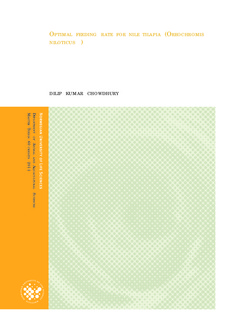| dc.description.abstract | The aim of this study was to define optimal feeding rates for Nile tilapia (Oreochromis niloticus). Four experiments were carried out to evaluate the effect of feeding rate on growth performance of larger and juvenile tilapia by means of estimating growth rates, apparent nutrient digestibilities, feed utilization, body compositions, and nutrient and energy retentions. One nutritionally balanced diet (crude protein 342, crude fat 67, ash 47, starch 251 (all values in g (kg dry matter)-1)) was prepared by extrusion and used in all experiments. The experiments were carried out in a freshwater recirculation system. The temperature was maintained at 25 to 26oC, pH at 6.8 and oxygen above 5 mg l-1. Duplicate tanks were used for each feeding rate treatment.
The first experiment was carried out with duration at six weeks, and utilized adult tilapia (258 ±0.3 g, mean±SEM). Fishes were fed six times in 24 hr photoperiod at five feeding rates (55, 70, 85, 100 and 115% where 2.25% body weight per day as 100% satiation). Daily weight gain was predicted assuming that the feed conversion ratio (FCR) was 1.1 g feed dry matter (DM) intake per g gain. Analysis of variance showed that 55% feeding rate is like to be proficient for FCR at 1.01. Energy content of tilapia was significantly higher at 100-115% feeding rate and intermediate at 55 to 85% feeding rate. Nitrogen retention was significantly higher at limited feeding rate (55%). Apparent crude protein digestibility was found significantly higher at 100% satiation and intermediate at 70, 85 and 115% feeding rate. The estimated optimal feeding rate was at the 55% level, corresponding to 1.2 % a day.
The second experiment was conducted over a 4 week period with juvenile tilapia (1.1±0.02 g) fed 22 times in 24 hr photoperiod at five feeding rates (55, 70, 85, 100 and 115% where 8 and 6% body weight per day considered as 100% satiation for 1st and 2nd two week, respectively). FCR was set at 0.8 g DM intake per g gain. Growth rates were significantly higher at 85-115% feeding rate while FCR (0.66 to 0.81) significantly lower at 55-85% feeding rate. Whole-body dry matter, crude protein, crude fat, and energy contents were significantly elevated for the highest feeding rates, while ash was reduced. Nitrogen, phosphorus and energy retentions were significantly lowered at restricted feeding. The estimated optimal feeding rate based on growth rates was 6.8% a day for the first 2 weeks and 5.1% for the next two weeks.
The third experiment was designed with 4 weeks feeding of juvenile tilapia (1.1±0.02 g) in accordance with same frequency and photoperiod as same as second experiment. Fishes were fed at four declining and one fixed feeding rate 8-16 to 8 and 6-14 to 6% body weight for 1st and 2nd two week respectively. Weight gain% and SGR were significantly higher at 10-8 and 8-6 to 16-8 and 14-6% feeding rate while FCR (0.66 to 0.71) were significantly lower at 10-8 to 8 and 8-6 to 6% feeding rate. Dry matter, crude protein, crude fat, ash and energy content were significantly affected by declining feeding rate and higher than initial body composition. Nitrogen and total phosphorus retentions were significantly higher at lesser feeding regime while energy retention was significantly higher at 12-8 and 10-6% feeding rate. The estimated optimal feeding rate based on growth rates was to reduce feeding from 10 to 8% a day for the first 2 weeks and from 8 to 6% for the next two weeks.
The fourth experiment was carried out at two week duration for larger tilapia (77.9±0.03 g). Fishes were fed at five feeding rate (1, 2, 3, 4 and 5% body weight a day) with same frequency and photoperiod as experiment 2 and 3. FCR was set at 0.9 g DM intake per g gain. Growth rates were significantly higher at 3 to 5% feeding rate while FCR (0.86 to 0.89) were significantly lower at 1 to 3% feeding rate. Dry matter and energy content were significantly increased by feeding rate but ash content was significantly decreased as feeding rate increase. Nitrogen retention was significantly higher at 1-3% feeding rate while energy retention at 3% feeding rate. The estimated optimal feeding rate based on growth rates was 3% a day.
In conclusion, correct feeding rate can be used for maximize growth and feed utilization for genetically improved Nile tilapia. Declining feeding rate is better than fixed feeding rate and can be suitable for Juvenile tilapia (1.1 g) at 10-8% and 8-6% for 1st and 2nd two week, respectively while 3% feeding rate can be proper for tilapia between 80 and 115 g. Tilapia larger than 260 g likely to be proficient at 1.2% body weight. | en_US |
